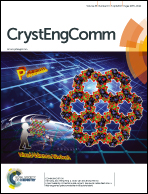Solvatomorphs of 25,26,27,28-tetrahydroxycalix[4]arene and 5,11,17,23-tetramino-25,26,27,28-tetrabutoxycalix[4]arene: quenching photoluminescence through switching the guest†
Abstract
Here, we have disclosed two solid state forms of 5,11,17,23-tetramino-25,26,27,28-tetrabutoxycalix[4]arene (1) and two solid state forms of the non-functionalized 25,26,27,28-tetrahydroxycalix[4]arene (2). This is the first structural knowledge of a tetra-amino functionalized calixarene derivative, even though this compound is well known and used as a precursor of several other functionalized calix[4]arenes. The two solid forms of 1 differ by the presence of either water or water/dimethylsulfoxide (DMSO) solvent molecules entrapped in the major calixarene cavity, even though the pinched conformation is adopted in both forms as a consequence of the contacts between solvent molecules and phenyl rings. Likewise, the switch from water to DMSO in the cone cavity of 1 has abrogated the photoluminescence (PL) found only in the dihydrate form. Frontier molecular orbital calculations at the B3LYP/6-31G* level of theory support a short-range electron transfer between guest (DMSO) and host (1) molecules quenching the solid state photoluminescence when DMSO is entrapped in the cone. This solvatomorphism approach for PL search in calixarenes opens a perspective on tuning and even increasing the performance of calixarenes through changing the guest solvent molecule. Similarly, the two crystal forms of 2 entrap either methyl alcohol or DMSO in their cones, which, as well as both crystal forms of 1, are packed into sheets through different fashions and contact patterns.
![Graphical abstract: Solvatomorphs of 25,26,27,28-tetrahydroxycalix[4]arene and 5,11,17,23-tetramino-25,26,27,28-tetrabutoxycalix[4]arene: quenching photoluminescence through switching the guest](/en/Image/Get?imageInfo.ImageType=GA&imageInfo.ImageIdentifier.ManuscriptID=C6CE02649D&imageInfo.ImageIdentifier.Year=2017)


 Please wait while we load your content...
Please wait while we load your content...